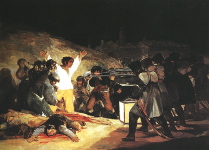Post by Frank Bramblett

I have nothing against concepts or theory, and even have been guilty of doing conceptual art. [I] believe that theory is critical to art, but believe that artists’ dependence on theory is terminal to art (shown, Lawrence Weiner’s “More or Less…Give or Take…).
 Many philosophers find that their “work” is theory and in theory … there is no practice. Many theorists see and sometimes envy the artist as the true theory practitioner. Over many decades the gap between the two has slowly eroded as artists’ work became closer and closer to theory (shown, Marcel Duchamp’s “The Bride Stripped Bare by her Bachelors, Even,” in the collection of the Philadelphia Museum of Art).
Many philosophers find that their “work” is theory and in theory … there is no practice. Many theorists see and sometimes envy the artist as the true theory practitioner. Over many decades the gap between the two has slowly eroded as artists’ work became closer and closer to theory (shown, Marcel Duchamp’s “The Bride Stripped Bare by her Bachelors, Even,” in the collection of the Philadelphia Museum of Art). The problem is that theory today leads the artist to such an extent that the “work” dies.
 …Much art today is illustration of theory, concept, idea. Part of the problem is with the “word.” Thoughts are concepts; words describe thoughts. Art is made to defend the words; art is then conceptual, or at least all that can be spoken about art is conceptual. The burden of the word becomes the limitation of what a work might become and the “artist” is mute. To execute a concept is … the death of the art (shown, John Baldessari’s Read, Write, Think, Dream).
…Much art today is illustration of theory, concept, idea. Part of the problem is with the “word.” Thoughts are concepts; words describe thoughts. Art is made to defend the words; art is then conceptual, or at least all that can be spoken about art is conceptual. The burden of the word becomes the limitation of what a work might become and the “artist” is mute. To execute a concept is … the death of the art (shown, John Baldessari’s Read, Write, Think, Dream).  Stand in front of the Third of May [by Goya] and you stand in the place of Maximillian–you understand the story, but you experience the inexplicable. I think that. I … believe that the theory, the concept, the idea is a result of a recognition of an understanding that is reached by the practice of work. This understanding cannot be explained.
Stand in front of the Third of May [by Goya] and you stand in the place of Maximillian–you understand the story, but you experience the inexplicable. I think that. I … believe that the theory, the concept, the idea is a result of a recognition of an understanding that is reached by the practice of work. This understanding cannot be explained.
I am a long time fan of R. Hughes (see previous post) and his simplistic way of describing complex relations of multiple contexts. Since a visit to the Prado a few years ago, I am a lover of Goya. I too look forward to his talk.
About the Malen event (see yesterday’s post): Sorry, but I had a different experience that had nothing to do with the “conceptual art” conversation. For me it was all downhill from the introduction announcing that she was obsessed. Obsessives deny as an alcoholic denies.
 I was at the back near the door, and recognized most of the laughter as coming from the mid to front. For those at the back, we could not see the slides. I became amused at the head in front bobbing back and forth in futile efforts to make the connection between the images and the words. Was this a strategy? Soon I began to fight laughter, not at what was being said or seen, but in Malen’s delivery and what I saw ahead (shown, one of Malen’s slides).
I was at the back near the door, and recognized most of the laughter as coming from the mid to front. For those at the back, we could not see the slides. I became amused at the head in front bobbing back and forth in futile efforts to make the connection between the images and the words. Was this a strategy? Soon I began to fight laughter, not at what was being said or seen, but in Malen’s delivery and what I saw ahead (shown, one of Malen’s slides).
My efforts to contain my laughter escalated as the efforts to slowly exit the squeaky door. Was her intention to create in me a condition of sympathy or futility? Was this not a presentation, but a study?
I was saved by the case studies at the end that, I agree, were of some amusement.
–Philadelphia painter Frank Bramblett won a 2000 Pew Fellowship in the Arts









